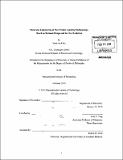Molecular engineering of new protein labeling methodology based on rational design and in vitro evolution
Author(s)
Choi, Yoon-Aa
DownloadFull printable version (18.72Mb)
Other Contributors
Massachusetts Institute of Technology. Dept. of Chemistry.
Advisor
Alice Y Ting.
Terms of use
Metadata
Show full item recordAbstract
Site-specific labeling using E coli biotin ligase (BirA) and its 15-amino acid "acceptor peptide" (AP) has been applied to study the function of various cellular proteins. In order to extend the capabilities of biotin ligase-based labeling, we engineered key elements of the labeling platform. First we characterized a novel peptide substrate (called "yeast acceptor peptide" (yAP)) for yeast biotin ligase (yBL) that had been evolved by phage display. Assays performed in vitro and on the yeast surface showed that the yBL/yAP pair was orthogonal to the BirA/AP pair, allowing two-color labeling of different proteins on cells with differently-colored probes. Second, to improve the kinetic efficiency of yAP, we developed a novel selection scheme based on yeast display. Model selections demonstrated up to 1000-fold enrichment, and three rounds of selection on a randomized peptide library were performed. Third, we attempted to improve the kinetic efficiency of BirA through evolution by in vitro compartmentalization (IVC). Because the original IVC protocol based on bead-linked DNA had many technical problems, we developed a novel bead-less IVC protocol. An enrichment factor of 25 was obtained in a model selection. Due to the single-turnover nature of the selection, however, this scheme was not able to enrich highly active catalysts over moderately active ones. In separate work, we turned our attention to the streptavidin-biotin pair. Again using bead-less IVC, we performed a selection for streptavidin mutants that could bind a ketone analog of biotin with high affinity. (cont.) Two rounds of selection were performed but characterization of enriched clones was not completed. Finally, we helped to discover a mutant ligase that could catalyze attachment of a fluorinated aryl azide photocrosslinker to proteins fused to a 17-amino acid peptide tag. The aryl azide probe was tested and shown to be accepted by a W37V mutant of E coli lipoic acid ligase (LplA).
Description
Thesis (Ph. D.)--Massachusetts Institute of Technology, Dept. of Chemistry, 2010. Cataloged from PDF version of thesis. Vita. Includes bibliographical references.
Date issued
2010Department
Massachusetts Institute of Technology. Department of ChemistryPublisher
Massachusetts Institute of Technology
Keywords
Chemistry.